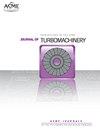涡轮端壁轮廓通过先进的优化技术
IF 3.1
3区 工程技术
Q3 ENGINEERING, MECHANICAL
引用次数: 0
摘要
非轴对称端壁剖面提供了同时减轻轴向涡轮气动损失和热气体摄入的功能。本文提出了一种优化方法,以产生具有真实几何效应的轮廓表面,如叶片圆角和边缘密封通道,目的是在减少热气体摄入的同时实现更高的效率。轮廓转子平台是构造使用b样条表面夹紧在轴向。在方位角方向上,表面是不固定的,以允许跨越周期边界的几何连续性。采用端壁参数化方法对高压涡轮级转子轮毂平台进行了优化设计。差分进化优化器用于根据效率对个体进行排序。单目标优化设置为最大化气动效率,并定义为通过混合出平均过程来解释流动不均匀性。采用两级高压涡轮发动机典型工况作为边界条件。几何和空气动力学约束的设置,以保证公平比较的个人和满足发动机的要求。提出了两种曲面参数化,这两种曲面参数化使用不同数量的设计变量,但具有相同的构造策略,以显示自由度数量与空气动力学改进之间的权衡。考虑了不同的吹扫流动条件,以评估在非设计条件下相关几何形状的优化结果的稳健性。本文的目的是展示所实现的参数化对具有技术效果的轮廓平台的先进形状灵活性,如叶片圆角和边缘密封通道。该工作为涡轮级端壁轮廓优化建立发动机实际约束提供了设计指导。本文章由计算机程序翻译,如有差异,请以英文原文为准。
TURBINE ENDWALL CONTOURING THROUGH ADVANCED OPTIMIZATION TECHNIQUES
Abstract Non-axisymmetric endwall profiling offers features to simultaneously mitigate aerodynamic losses and hot gas ingestion in axial turbines. This paper presents an optimization methodology to generate a contoured surface integrated with real geometrical effects such as blade fillets and a rim seal channel with the aim of achieving higher efficiencies while reducing hot gas ingestion. The contoured rotor platform is constructed using a B-spline surface clamped in the axial direction. In the azimuthal direction, the surface is unclamped to allow geometrical continuity across the periodic boundaries. The endwall parameterization is used to optimize a rotor hub platform of a high-pressure turbine stage. A differential evolution optimizer is used to rank individuals in terms of efficiency. The single-objective optimization is set to maximize the aerodynamic efficiency and it is defined such that it accounts for the flow non-uniformity through a mixed-out averaging procedure. Engine representative conditions typical of a two-stage high-pressure turbine are used as boundary conditions. Geometrical and aerodynamic constraints are set to guarantee a fair comparison among individuals and to meet engine requirements. Two surface parameterizations, which use a different number of design variables but share the same construction strategy, are presented to show the trade-off between the number of degrees-of-freedom and the aerodynamic improvement. Different purge flow conditions are considered to assess the robustness of the optimization results at off-design conditions for relevant geometries. The aim of this paper is to show the advanced shape flexibility of the implemented parameterization for contoured platforms featuring technological effects such as blade fillet and rim seal channel. The work provides design guidelines to setup engine-realistic constraints for endwall contour optimization of turbine stages.
求助全文
通过发布文献求助,成功后即可免费获取论文全文。
去求助
来源期刊
CiteScore
4.70
自引率
11.80%
发文量
168
审稿时长
9 months
期刊介绍:
The Journal of Turbomachinery publishes archival-quality, peer-reviewed technical papers that advance the state-of-the-art of turbomachinery technology related to gas turbine engines. The broad scope of the subject matter includes the fluid dynamics, heat transfer, and aeromechanics technology associated with the design, analysis, modeling, testing, and performance of turbomachinery. Emphasis is placed on gas-path technologies associated with axial compressors, centrifugal compressors, and turbines.
Topics: Aerodynamic design, analysis, and test of compressor and turbine blading; Compressor stall, surge, and operability issues; Heat transfer phenomena and film cooling design, analysis, and testing in turbines; Aeromechanical instabilities; Computational fluid dynamics (CFD) applied to turbomachinery, boundary layer development, measurement techniques, and cavity and leaking flows.

 求助内容:
求助内容: 应助结果提醒方式:
应助结果提醒方式:


